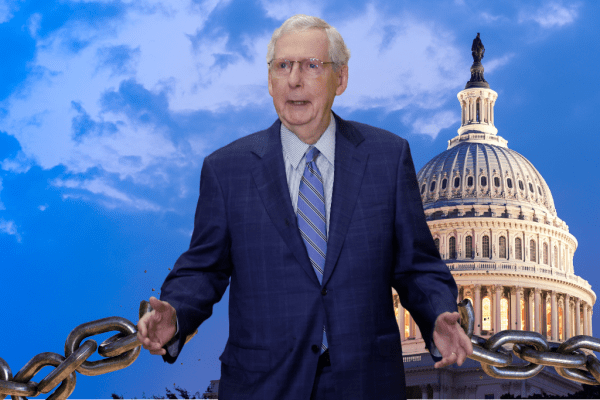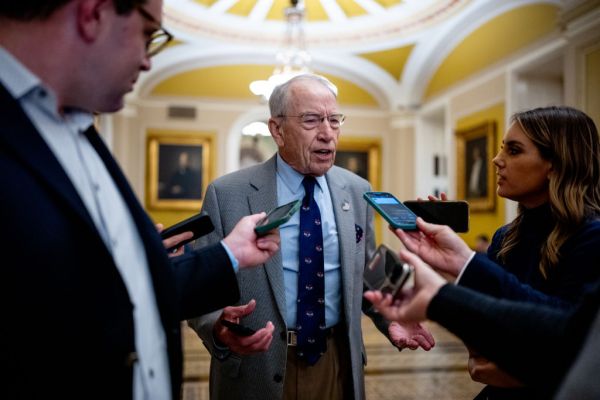Happy Tuesday! We hope you all enjoyed your long weekend as much as we did. On to the news!
Quick Hits: Today’s Top Stories
-
The United States confirmed 24,936 new cases of COVID-19 yesterday, with 4.2 percent of the 588,909 tests reported coming back positive. An additional 274 deaths were attributed to the virus on Monday, bringing the pandemic’s American death toll to 189,206.
-
In the midst of ongoing demonstrations, Belarusian opposition leader Maria Kolesnikova—a member of the opposition Coordination Council set up to ensure a power transfer—has disappeared. Witnesses claim to have seen her being abducted by masked men in a public park in Minsk, while Belarusian police have denied detaining her.
-
In an afternoon press conference on Monday, President Trump called Joe Biden a “stupid person” and described Sen. Kamala Harris as “not a competent person,” excoriating them for questioning whether the White House was pushing a politicized vaccine timeline. He also defended himself from the article in The Atlantic that claimed he had called veterans “suckers,” arguing that soldiers loved him in spite of their commanders, who, in his telling, “want to do nothing but fight wars” in order to make money for arms manufacturers.
-
On Sunday, California Gov. Gavin Newson declared a state of emergency in Fresno, Mariposa, San Diego, and San Bernardino counties as fires continue to burn across California, which is enduring a heat wave. A record 2 million acres have burned this year.
-
Democrats on the House Committee on Oversight and Reform are launching an investigation into whether Postmaster General Louis DeJoy reimbursed employees at his former company for donating money to GOP candidates he supported.
-
Alexei Navalny, the Russian opposition leader who German doctors maintain was poisoned, has been brought out of a medical coma and is responsive.
The Home Stretch

Every four years, Labor Day kicks off the final two months of a presidential election cycle, the most intense period in American politics. It’s here.
In 2020, these final months will take place during a global pandemic and a deep recession, with pockets of civil unrest serving as reminders of deeply strained racial relations and simmering anger from protesters, counterprotesters and those caught in their battles. Our politics are more polarized than at any time in recent memory and candidates for office routinely make apocalyptic predictions about the consequences of victory by their partisan rivals. Hostile foreign governments seek to disrupt the election and even the intelligence community’s warnings about those capabilities and intentions have been weaponized for partisan purposes.
Through all of this, polling of the presidential race has been surprisingly stable: Joe Biden is a heavy favorite to win, currently boasting a 7 percent polling average lead nationwide. The Economist election projection has Trump’s odds of winning at 1 in 6. Sean Trende, the senior elections analyst at RealClearPolitics puts Trump’s chances at 1 in 7. Election forecaster FiveThirtyEight has Trump’s odds at closer to 3 in 10.
RealClearPolitics’ nationwide polling average shows Biden carrying registered voters by 49.9 percent compared to Trump’s 42.8 percent. Trump seems virtually certain to lose the popular vote—the Economist puts his chances at less than 4 percent—and a Trump landslide appears equally unlikely. But swing state polls suggest show a tighter race. The president trails Biden by 3.2 points across the six states most likely to determine the election, according to RealClearPolitics’ top battleground polling numbers in North Carolina (Biden +0.6), Wisconsin (Biden +5.0), Florida (Biden +1.8), Michigan (Biden +2.6), Pennsylvania (Biden +4.2) and Arizona (Biden +5.0).
Trump’s greatest advantage lies in the intensity of his support. In a September 3 poll, CNN asked Trump-supporting survey respondents: “Is that more a vote FOR Donald Trump or more a vote AGAINST Joe Biden?” (and reversed the question for Biden backers). While 77 percent of registered voters backing Trump say they are voting for the president rather than against his opponent, only 45 percent of Biden’s supporters say the same about their preferred candidate.
Four years ago this week, large majorities of voters told pollsters that the country was on the wrong track—a favorite metric of election prognosticators. About seven in 10 voters told Gallup that they were dissatisfied with the direction of the country, a finding Trump supporters used to argue that voters wanted change. Those same numbers today (in surveys conducted in early August) find voters even more pessimistic, with 84 percent dissatisfied and only 13 percent say they’re satisfied. A more recent Economist/YouGov Poll (conducted between August 30 and September 1) indicates a slightly sunnier outlook but overall tells a similar story: 25 percent of registered voters believe we are generally headed in the right direction, whereas 67 percent say we are off on the wrong track.
Partisanship also affects how Americans plan to vote. According to a Pew Research Center poll from August 13, “Most registered voters who support Trump or lean toward supporting him would rather vote in person in the presidential election (80%), either on Election Day (60%) or earlier (20%).” Only 17 percent of Trump supporters said they would vote by mail. By contrast, a striking 58 percent of respondents who said they support or lean toward supporting Biden said they plan to mail in their ballots. Never before have we seen such a stark partisan gap in voters’ preferences for in-person versus mail-in voting.
The gap has some Republicans worried. So does the president’s downtalking of mail-in-balloting. House Minority Leader Kevin McCarthy told Axios that he’s very concerned about the effects of Trump’s rhetoric on down-ballot Republicans. “We could lose based on that,” McCarthy told Alayna Treene, noting in particular concerns about the GOP’s older voters. “I tried to show him … you know who is most afraid of COVID? Seniors. And if they’re not going to go vote, period, we’re screwed.”
It’s a complaint we’ve heard consistently from top Republicans, too. While Trump heaps scorn on mail-in-voting—mixing legitimate gripes about abrupt changes to the process with wild accusations of malfeasance and fraud—he’s almost certainly hurting his own party. And while his preemptive complaints provide him an excuse if he ends up losing, discouraging Republicans from voting by mail likely means fewer Republican votes for his party-mates.
While there appears to be little chance that Republicans will win back the House of Representatives, prospects for retaining control of the Senate seem brighter. Top Republican fundraisers have quietly been telling donors to invest their resources in the Senate as the most realistic hope of keeping Democrats from a complete sweep into power on November 3. It seems to be working; money has been pouring into top Senate races and SuperPacs and several key Senate races have tightened in recent weeks. According to the RealClearPolitics average of North Carolina’s race, Democratic candidate Cal Cunningham carries only a 4-point average lead over Republican candidate Thom Tillis, down from a 10 point gap in early August. In Texas, Sen. John Cornyn holds a near double-digit advantage over challenger MJ Hegar, and while reliable public polling is scarce in Montana, private polling shows incumbent Sen. Steve Daines holding onto a small lead over Democrat Gov. Steve Bullock. Trump received a slight bounce after the Republican convention last month, with his job-approval rating now 3 points higher than the beginning of the summer. Down ballot, Senate candidates in battleground states have seen their numbers improve with the president’s.
Still, as Sarah and Andrew detailed in The Sweep last month, the most salient fact across all Senate contests is still that the GOP has an extremely unfavorable map this year. The Cook Political Report considers 12 races to be quite close this year—rated either “Lean Democrat,” “Toss Up,” or “Lean Republican.” A full 10 of these 12 are currently held by Republicans. So no matter how much these races tighten, Republicans are still looking at little upside—and the possibility for a crippling set of losses.
This is the snapshot today—two months out. But as we’ve seen, things can change quickly. And with the number of black swans in 2020 approaching a flock, there may well be more surprises ahead. Broader civil strife? A dramatic improvement in COVID numbers? Or a delayed spike in cases and deaths after the tentative resumption of schools? A candidate stricken by the virus—or maybe a vaccine? Big changes in our economic outlook? A national security crisis?
One thing we know we’ll face: Continued efforts from hostile nations to disrupt the election and influence its outcome. William Evanina, director of the National Counterintelligence and Security Center, released a report last month on the state of election interference. The language was clear: “foreign states will continue to use covert and overt influence measures in their attempts to sway U.S. voters’ preferences and perspectives, shift U.S. policies, increase discord in the United States, and undermine the American people’s confidence in our democratic process.” In other words, we’re already seeing a wave of foreign meddling from China, Russia, and Iran. And we can expect these countries to continue sow doubt in Americans’ faith in their democratic institutions come November.
Welcome to Capitolism
Last week we told you we were launching a new newsletter from Scott Lincicome. Well, today’s the day! In the first edition, Scott explains that he will be writing weekly on the “wild world of Washington wonkery.”
This, of course, will include trade and international economic policy (something I’ve also taught at Duke), but we’ll also look at other pressing or trendy economic issues of the day—things like wage stagnation, supply chains, “deindustrialization,” living standards, physical and occupational mobility, entitlement spending, and so on—citing to the latest data or research from think tanks and academia and then translating it (well, trying to, at least) into language that normal, non-nerds can more easily understand. For example, I’ll soon be taking a deep dive into the theory and history behind economists’ longstanding aversion to tariffs and then look at the actual results of those policies in recent years (spoiler: They’re not great, Bob.)
Beyond those lessons, we’ll look at how broader economic and policy concepts—the “seen versus unseen,” opportunity costs, “public choice,” price signals, etc.—fit into our daily lives, highlighting the weird, wonderful, and often hilarious world that is the free(ish) market.
Scott approaches these issues with a clear perspective—capitalism is a force for good. But you’ll find that Scott is anything but dogmatic, always testing his assumptions based on facts and data. (Except when it comes to the proper way to make nachos, where he’s mulish in his devotion to dressing each individual tortilla chip, one-by-one.)
Of course, I will have a viewpoint—freer markets are (usually) better markets; things are (mostly) getting better all the time; good intentions and $2.70 will get you a cup of coffee; etc.—and will argue for certain positions and against others. (And, not too long ago, these “Hayekian fundamentalist” viewpoints were pretty common among conservatives too!) Given the rise of economic populism and nationalism on the left and the right, I will certainly devote ample space here to debunking some of the most well-worn myths about “libertarianism,” trade, immigration, jobs, living standards, and other issues that buttress those growing, illiberal movements. I’ll also devote more than a few characters to the wonders of modern capitalism that we all—even me!—take for granted every day (though I still smile at my supermarket’s $10 dozen of roses—hooray cheap luxury!).
What’s it going to look like?
I expect the format of Capitolism to be somewhat similar to what you’ve experienced among the other newsletters: a main “column” on the news and issue of the week, followed by a couple sections of quicker hits on relevant and irrelevant matters. This may include but not be limited to (1) a Chart of the Week, with some sort of eye-popping data on a popular policy issue; (2) some bizarre (hilarious) product or service showing how Markets Are Weird; (3) since we do love consumption here at Capitolism, a somewhat serious (unpaid) endorsement for a miraculous product that I just can’t live without; (4) a healthy dose of dad jokes and puns (which, it should be noted, are considered by #science to be a sign of incredible wit and intelligence); and/or (5) quick links to some of the best policy writing that I’ve read that week.
One important note: If you want to receive Capitolism in your inbox, you must opt-in here. The first few editions will be sent to all of our readers who opt-in, but after that the newsletter will go only to paid members. If you would to receive Capitolism to your inbox, please go add it to your preferences here.
Worth Your Time
-
You might look at Mulan’s beautiful mountain scenery in a different light after reading Isaac Stone Fish at the Washington Post. “The most devastating part of ‘Mulan,’” Fish writes, “isn’t the story. It’s the credits.” Fish blasts Disney for thanking four CCP propaganda bureaus and the Public Security Bureau of the city of Turpan—all of which operate in the Xinjiang region. By accepting the aid of these agencies and filming in Xinjiang, Fish writes, Disney “worked with regions where genocide is occurring, and thanked government departments that are helping to carry it out.”
-
American Compass, a new think tank founded by economist Oren Cass, chose this Labor Day to launch a monthlong policy forum, “A Seat at the Table: A Conservative Future for the American Labor Movement.” The group started off with a statement signed by, among others, Yuval Levin, Marco Rubio, and Jeff Sessions, arguing for the importance of organized labor as “vital mediating institutions” and advocating for the consideration of various labor law reforms. “We endorse no specific proposal,” they write, “but believe that various combinations hold the potential for substantive reform that would advance our priorities of improving the lives of workers and their families, deepening our communities, and strengthening the nation.”
-
For months, there have been whispers among top Republicans about the astonishing spending of the Trump campaign. An investigation by two of the top New York Times political reporters, Maggie Haberman and Shane Goldmacher, finds many reasons to justify those concerns. “Of the $1.1 billion his campaign and the party raised from the beginning of 2019 through July, more than $800 million has already been spent. Now some people inside the campaign are forecasting what was once unthinkable: a cash crunch with less than 60 days until the election, according to Republican officials briefed on the matter.” Under former campaign manager Brad Parscale, “more than $350 million—almost half of the $800 million spent—went to fund-raising operations, as no expense was spared in finding new donors online.” Those lists, of course, have value well beyond the end of the current campaign.
Presented Without Comment
Also Presented Without Comment
Toeing the Company Line
-
David’s Sunday French Press stresses the importance of responsible gun ownership and discusses the American social compact: “the government recognizes and defends fundamental individual liberty, and the individual then exercises that liberty virtuously, for virtuous purposes.” But he’s dismayed that two recent events—the McCloskeys waving guns at protesters in St. Louis and Kyle Rittenhouse’s arrest in Kenosha on charges of shooting three protesters, two fatally—have left many Christians celebrating irresponsible and reckless behavior.
-
Danielle Pletka questions whether Democrats will be any better at promoting democracy than Donald Trump has been. While noting Trump’s affinity for cozying up to tyrants and his own autocratic leadership style, Pletka points out some examples of hypocrisy from Democrats.
-
On Friday’s Dispatch Podcast, Sarah and Steve welcomed conservative commentator and talk radio guru Erick Erickson for a wide-ranging discussion on politics, the conservative movement, the 2020 election, and the need for grace. Erick walks through his reasons for supporting Donald Trump over Joe Biden, while admitting that some days he thinks about just staying home instead. If you’re interested in reading Erick’s newsletter, “Confessions of a Political Junkie,” you can check it out here.
Let Us Know
We hope you’re as excited as we are to have Scott Lincicome on the team. Drop a dad joke in the comments to welcome him aboard.
Reporting by Declan Garvey (@declanpgarvey), Andrew Egger (@EggerDC), Charlotte Lawson (@charlotteUVA), Audrey Fahlberg (@FahlOutBerg), James P. Sutton (@jamespsuttonsf), and Steve Hayes (@stephenfhayes).








Please note that we at The Dispatch hold ourselves, our work, and our commenters to a higher standard than other places on the internet. We welcome comments that foster genuine debate or discussion—including comments critical of us or our work—but responses that include ad hominem attacks on fellow Dispatch members or are intended to stoke fear and anger may be moderated.
You are currently using a limited time guest pass and do not have access to commenting. Consider subscribing to join the conversation.
With your membership, you only have the ability to comment on The Morning Dispatch articles. Consider upgrading to join the conversation everywhere.